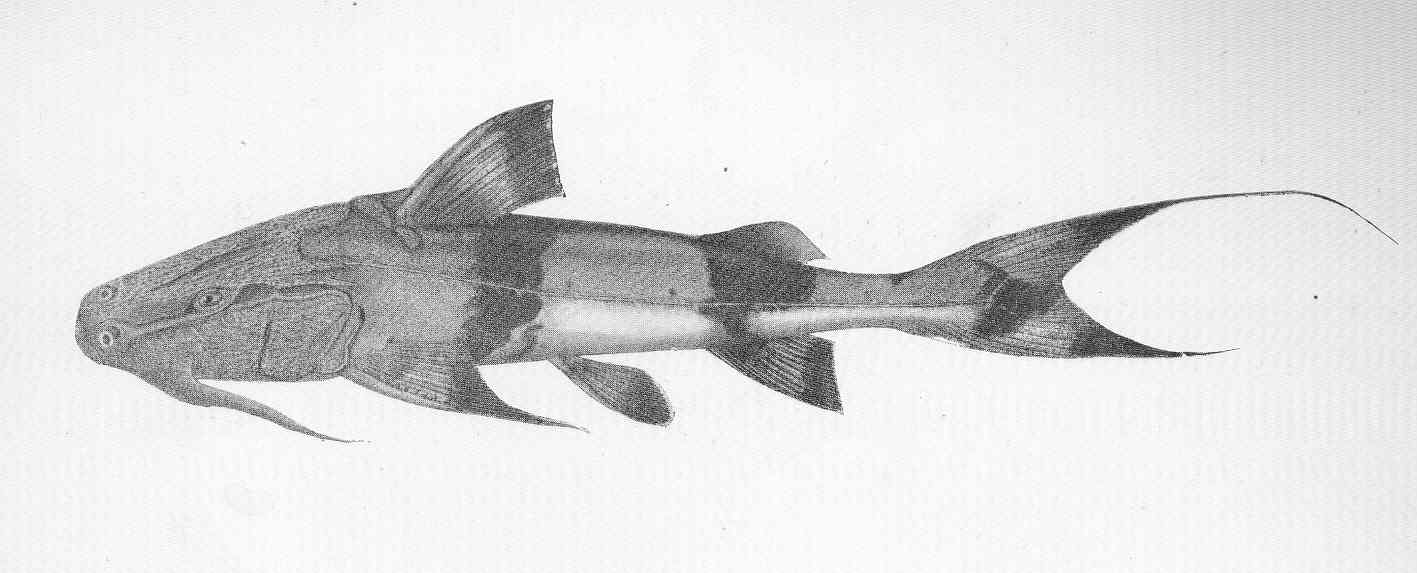- Bagarius
Taxobox
fossil_range =Pliocene - Recent
name = "Bagarius"

image_width = 250px
image_caption = "Bagarius yarrelli "
regnum =Animalia
phylum =Chordata
classis =Actinopterygii
ordo =Siluriformes
familia =Sisoridae
subfamilia =Sisorinae
genus = "Bagarius"
genus_authority = Bleeker, 1854
type_species = "Pimelodus bagarius"
type_species_authority = Hamilton, 1822
subdivision_ranks = Binomial name
subdivision =
"Bagarius bagarius"
(Hamilton, 1822)
"Bagarius gigas" †
Gunther, 1876
"Bagarius rutilus"
Ng & Kottelat, 2000
"Bagarius suchus"
Roberts, 1983
"Bagarius yarrelli"
(Sykes, 1839)"Bagarius" is a
genus ofcatfish es (order Siluriformes) of the familySisoridae . It includes four extantspecies , "B. bagarius", "B. rutilus", "B. suchus", and "B. yarelli" (Goonch catfish), and one extinct species, "B. gigas".cite journal|url=http://silurus.acnatsci.org/ACSI/library/biblios/2007_Ferraris_Catfish_Checklist.pdf|title=Checklist of catfishes, recent and fossil (Osteichthyes: Siluriformes), and catalogue of siluriform primary types|first=Carl J., Jr.|last=Ferraris|journal=Zootaxa |volume=1418|pages=1–628|year=2007|format=PDF ] cite journal|url=http://www.mapress.com/zootaxa/2006f/zt01345p096.pdf|title=Genera of the Asian Catfish Families Sisoridae and Erethistidae (Teleostei: Siluriformes)|first=Alfred W.|last=Thomson|coauthors=Page, Lawrence M.|journal=Zootaxa |volume=1345|pages=1–96|year=2006|format=PDF ]Distribution
"Bagarius" species inhabit south and southeast
Asia .cite journal|title=Revision of the South and Southeast Asian Sisorid Catfish Genus "Bagarius", with Description of a New Species from the Mekong|first=Tyson R.|last=Roberts|journal=Copeia |year=1983|issue=2|pages=435–445|doi=10.2307/1444387|volume=1983] They are distributed in the Indus drainage inPakistan andIndia , east (including peninsular India) to theRed River drainage inVietnam and south throughoutIndochina including theMalay Peninsula andIndonesia . "B. bagarius" is known from theGanges River , Chao Phraya, and the Mekong drainages, as well as the Malay Peninsula and theSalween and Mae Klong drainages and theBrahmaputra River andAyeyarwady River . "B. suchus" originates from the Mekong and Chao Phraya basins. "B. rutilus" inhabits the Red River andMa River in northern Vietnam. "B. yarelli" is widely distributed in southern and southeastern Asia.Fossil record
"B. gigas" is reportedly from the
Eocene , however this age has been questioned.The oldest known sisorid fossil is "B. bagarius" found in Sumatra and India of the
Pliocene .cite journal|url=http://rmbr.nus.edu.sg/rbz/biblio/55/55rbz147-155.pdf|title=A Review of the Catfish Genus "Pseudexostoma" (Siluriformes: Sisoridae) with Description of a New Species from the Upper Salween (Nujiang) Basin of China|first=Wei|last=Zhou|coauthors=Yang, Ying; Li, Xu; Li, Ming-Hui|journal=The Raffles Bulletin of Zoology|year=2007|volume=55|issue=1|pages=147–155|format=PDF ]Description
"Bagarius" species have a broad head that is moderately or strongly depressed. The mouth is broad and terminal or slightly inferior. The
gill openings are wide. Thedorsal fin andpectoral fin s have strong spines. The dorsal fin spine is smooth, and the pectoral fin spine is smooth anteriorly and finely serrate posteriorly. The dorsal, pectoral, andcaudal fin lobes sometimes with filamentous extensions. The head and body is entirely or almost entirely covered by heavilykeratin ized skin superficially differentiated into unculiferous plaques ortubercle s. "Bagarius" species lack a thoracic adhesive apparatus and paired fins are unplaited."Bagarius" species have the same general colour pattern consisting of three darkly pigmented bands or blotches on the body. Irregularly placed spots may also be present on the body. The fin pigmentation varies from species to species, from plain, to spotted, to slightly or heavily barred. Also, some "B. yarelli" may have a heavily spotted pattern like a
Dalmatian dog that obscures the main barred pattern.In "B. bagarius", the pelvic fin origin is normally anterior to a vertical line through the base of the last dorsal fin ray, while in "B. yarelli" the pelvic fin origin is posterior to this vertical line. Also, in most "B. bagarius", the
adipose fin originates far back over theanal fin , on a vertical through the base of the third or four anal fin ray. However, in most "B. yarelli", the adipose fin originates near or in front of a vertical line through the anal fin origin. In "B. suchus", the adipose fin originates even further back than in "B. bagarius" or "B. yarelli". "B. suchus" tends to have a flatter head and body than either "B. bagarius" or "B. yarelli"."B. bagarius" does not exceed much past 20
centimetre s (7.9 in) SL. "B. rutilus" grows to about 100.0 cm (39.4 in) SL.FishBase species|genus=Bagarius|species=rutilus|year=2007|month=July] "B. suchus" grows to about 70.0 cm (27.6 in) SL.FishBase species|genus=Bagarius|species=suchus|year=2007|month=July] "B. yarelli" grows very large, reaching about 200 cm (78.7 in) SL.Ecology
"B. bagarius" inhabits rapid and rocky pools of large and medium-sized rivers.FishBase species|genus=Bagarius|species=bagarius|year=2007|month=July] "B. suchus" is usually associated with rapids in the large rivers it inhabits. "B. yarelli" occurs in large rivers on the bottom, even with swift current, never entering small streams. It is found among boulders, often in the white water of the rapids where it apparently is indifferent to the strong current.FishBase species|genus=Bagarius|species=yarelli|year=2007|month=July]
"B. bagarius" is primarily entomophagous. It also feeds on small fishes, frogs and shrimps. "B. suchus", however, is a
piscivore . "B. yarelli" feeds primarily onprawn s but also eat small fishes and aquatic insects."B. bagarius" and "B. yarelli" breed in rivers prior to the beginning of the annual flood season.
"B. yarelli" migrates in schools. It is reported to migrate to follow its prey. It is also reported that it follows "
Catlocarpio siamensis " during its upstream migration. Apparently the main upstream migration begins close to the peak of flood, when the current is very strong and the water is turbid.Relationship to humans
"Bagarius" species are marketed fresh, and are important as a food fish, but the meat spoils rapidly and can cause illness. The Goonch catfish has become an object of media attention as reports have surfaced of some of these fish feeding on funeral pyres in India. There is speculation that some drownings have also been caused by large specimens who have "developed a taste" for human flesh from the corpses and subsequently have attacked bathers in the river. This is the subject of a TV documentary aired in October 2008.cite news|url=http://www.thesun.co.uk/sol/homepage/news/weird/article1784470.ece|title=Mutant fish called Goonch..|publisher=The Sun|accessdate=2008-10-10]
References
Wikimedia Foundation. 2010.
